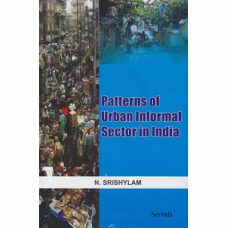Patterns of Urban Informal Sector in India |
Author :
N. Srishylam
ISBN: 9788183876315
Year: 2014
Pages: 168
Binding: HB
Publisher Name: Serials Publications
ISBN: 9788183876315
Year: 2014
Pages: 168
Binding: HB
Publisher Name: Serials Publications
Price:
Price in Dollar: $50
INR 995.00
Price in Dollar: $50
Qty:
"Patterns of Urban Informal Sector in India' deals with the growing urban informal sector in India, causative factors, occupation related issues, public policies and prospective suitable measures to protect the interests of the crores of people working in it for their livelyhood. From the beginning of the planned economic era, the development perspective has been biased towards urbanisation. The urban areas have become magnetic centers of growth and employment. Migration in abnormal magnitude from rural to urban due to near absence of productive employment in rural areas has created a bulging informal economy. Sheer negligence of agriculture and almost vanished rural artistic occupations has forced millions of rural population to migrate to urban conglomerations to fit into one or the other urban oriented jobs. Latest statistics speaks that 93 per cent of work force is depending on informal sector, primarily urban dominated activities. The ever growing urbanisation ha5 been enlarging the scope employability. The earlier rural specific occupations now turned into urban oriented. Occupations such as beedi making, construction, petty trading are providing bulk of employment to the migrated rural unskilled and semi-skilled labour displaced particularly by so called globalisation led modern economic development. People working in informal sector earlier known as unorganised sector are facing many challenges due to uncertain and insecure nature of its job market. Though the government has promulgated legal provisions for the welfare of informal labour, the implementation has its own lacunas. Still the living conditions of informal work force are at stake and there is every need to implement the constitutional obligations and to provide ample safety nets to the informal working class. Infact, the urban informal work force is living in highly adverse socio-economic and environmental conditions. Lack of accessibility to nutritional food, safe drinking water, sanitation, education and health care, housing and improper work environment are challenging the very existence of people living on informal sector. The present book has gone into many facets of urban informal economy and thrived to putforth many alternative policy perspectives to protect the informal sector in general and the urban informal sector in particular.
Contents 1. Conceptual Framework 2. Informal Sector—Policy Perspectives 3. Methodological Approach 4. Socio-economic Dimensions of Urban Informal Economy 5. Summary and Conclusion
Write a review
Your Name:Your Review: Note: HTML is not translated!
Rating: Bad Good
Enter the code in the box below:




